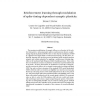286 search results - page 19 / 58 » Using inaccurate models in reinforcement learning |
NECO
2007
13 years 7 months ago
2007
Learning agents, whether natural or artificial, must update their internal parameters in order to improve their behavior over time. In reinforcement learning, this plasticity is ...
NECO
2007
13 years 7 months ago
2007
The persistent modification of synaptic efficacy as a function of the relative timing of pre- and postsynaptic spikes is a phenomenon known as spiketiming-dependent plasticity (...
PKDD
2010
Springer
13 years 5 months ago
2010
Springer
Abstract. We present an implementation of model-based online reinforcement learning (RL) for continuous domains with deterministic transitions that is specifically designed to achi...
NIPS
1996
13 years 9 months ago
1996
Dynamic Programming, Q-learning and other discrete Markov Decision Process solvers can be applied to continuous d-dimensional state-spaces by quantizing the state space into an arr...
FSTTCS
2006
Springer
13 years 11 months ago
2006
Springer
We propose a new approach to verification of probabilistic processes for which the model may not be available. We use a technique from Reinforcement Learning to approximate how far...

